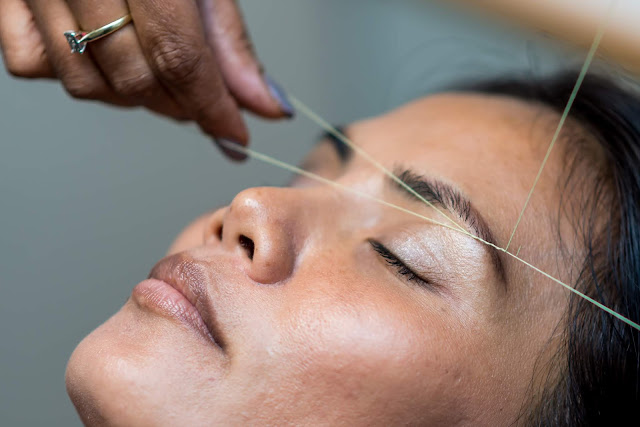 |
| Unwanted Hair During Menopause |
Things You Need to Know About Unwanted Hair During Menopause
There is no denying that menopause brings about a wide range of changes in your body. For some women, the absence of monthly periods is a welcome change; however, increased facial hair isn't. As much as you may worry, it is common to notice increased facial hair growth during and after menopause. That's right — you aren't the only one!
To learn more about this topic, here is everything you need to know about unwanted hair during menopause.
1. Why is there an increase in facial hair growth?
No matter your age, you will have an abundance of hair follicles on your face. Before menopause, these follicles produce soft hairs that are usually unnoticeable. This short, soft type of hair is known as vellus. However, during and after menopause, these follicles start to produce coarse hairs called terminal hairs. The shift occurs because of changes in your hormones due to menopause.
Throughout your childbearing years, your ovaries generate substantial amounts of estrogen (the female hormone) as well as some testosterone (the male hormone). However, throughout menopause, your ovaries start to produce a lot less estrogen, while still maintaining the same level of testosterone. Testosterone converts to dihydrotestosterone (DHT), which prompts the growth of the terminal hair that you may see on your upper lip, chin, and jawline.
In other words, your hormone levels start to shift, and the relative abundance of testosterone can prompt the growth of scattered yet coarse facial hair.
2. What can I do about it?
Luckily, there are a few different treatment options available that can help you with this issue. If you only have a couple of facial hairs, then you can start by using tweezers to remove them. However, if there is a significant amount or if you are uncomfortable with how it looks, then you can look into other options.
 |
| Threading utilizes thin, doubled thread which is pulled tight and worked across the area in question. |
- Plucking, waxing, or threading. These three methods work by pulling the hair out at the root. Plucking is something you can do at home with your tweezers – just don't forget to frequently clean your tweezers to decrease the likelihood of infection. If plucking is taking too long, then you may be interested in waxing instead, which can remove a lot more hair in a shorter time. Threading, on the other hand, utilizes thin, doubled thread which is then pulled tight and worked across the area in question. Generally, it is recommended that you see a professional for your waxing or threading needs.
- Creams. If necessary, you can get a prescription for a topical cream that can be used on the affected area. However, these creams can often be expensive, and many women find that their skin is too sensitive to the chemicals found in them.
- Laser. The light utilized in laser hair treatment overheats the hair follicle, resulting in damage that means the hair cannot continue to grow. While many women have success with this form of hair removal, it can often be very expensive as it requires many sessions and isn't guaranteed to be permanent. Additionally, this method does not work on fine or light-colored hair.
- Electrolysis. In recent years, electrolysis hair removal treatment has become popular as more and more women recognize the benefits. Similar to plucking, during electrolysis treatment, a thin mechanism works on one hair at a time. When this mechanism inserts the hair follicle, a small electrical current is given off which, in turn, heats the follicle and then destroys it. The benefit of electrolysis is that it is permanent, although it may take a few months of treatment.
3. How do I know if it is something more serious?
Most of the time, there is no serious underlying condition causing the change in hair growth. However, if you notice that coarser hair is also growing on other parts of your body, you certainly want to go and have your doctor check it out. If hair growth is accompanied by exhaustion, pelvic pain, acne, or sleep disruption, you may be suffering from polycystic ovary syndrome (PCOS) which is when small cysts have formed on the ovaries.
The other severe potential issue relates to your adrenal glands, which are the glands responsible for producing hormones. If they are acting dysfunctionally, it could be due to adrenal tumors or cancer, congenital adrenal hyperplasia, or Cushing's disease, all of which cause excess hair growth.
Final Thoughts
No one likes to deal with an increase in facial hair, but you can take comfort in knowing that you are not the only one affected by this condition. In fact, most women who are going through menopause are going to have a similar experience. Luckily, this change in hair type and increase in growth can be managed.
If you are dealing with this issue or have dealt with it in the past, let us know any tips and tricks you have in the comments below.
Contributor: Mariela Marcantetti is the Co-Founder and Chief Executive Officer of Furless with centers in Dubai and Abu Dhabi. The company offers the latest and only FDA-confirmed treatment to provide permanent removal results to unwanted hair. Mariela is deeply committed to responsible corporate practices and has an active role in her staff's professional and personal advancement within the electrolysis field and beyond.









0 Comments
Check out a variety of hairstyles, haircare, beauty tips, fashion, Motivation, and more on this beauty blog. Follow us on our social media sites.